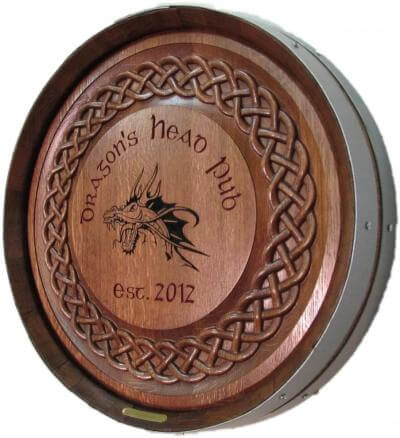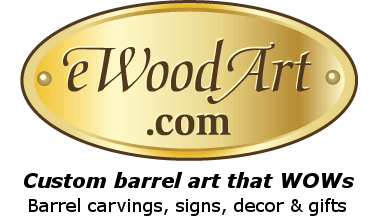Decorative Wood Carvings – 2D vs 3D
Isn’t every carving inherently 3 dimensional you might well ask ?
Well, yes, in the sense that carving into any material results in a surface with at least some depth, and therefore at least some 3-dimensionality. However, the distinction we’re making here is between a carved surface that is comprised of curves in 3D space, versus one comprised of lines or pocketed areas carved into a flat surface. This Dragon’s Head Pub barrel head carving incorporates examples of both. The intricate celtic weave border is 3D, while the dragon and text are 2D. Lets look into both of these styles of carving a little deeper, especially as they apply to decorative wood carvings.

3D Carvings:
Examples of true 3D carvings include dimensionally realistic works like statues or busts where the subject matter is rendered realistically in all 3 dimensions. These are generally free-standing pieces that look dimensionally realistic when viewed from any direction. Another example of 3D carving is a relief model, like one would find sculpted on the side of a monument, cast on a coin or carved into a flat piece of wood. In a relief carving (or sculpture or casting) the subject matter has been “flattened” in the direction perpendicular to the material, and any over-hanging elements have been eliminated. The amount of flattening is often referred to as “high”, “medium” or “low” relief, but all are examples of 3D. (Note: though relief models are comprised of curves in 3D space, they are often referred to as “2.5D” in machining contexts, since no overhanging elements are possible in the “z” direction.)
A traditional wood carver using hammer and chisel, creates rich 3D carvings using combinations of curved blades and angled cuts, requiring lots of skill and lots of time. Today’s computer aided carving systems use the power of the computer and the precision of a computer controlled router to achieve a similar result. This does generally require many hours of very finely controlled, closely spaced cutting passes with very small bits, but is far faster, more efficient and cheaper than traditional wood carving.
Computer controlled 3D carving requires that a computer “model” of the 3D object first be generated – either with the aid of 3D modeling software, or by scanning and storing the coordinates of an existing 3d object. The 3D model is then processed by other software to generate “tool paths”, large files of detailed tool control commands used to drive the cutting surface over the material to carve the 3D object.
Creating 3D models of complex shapes (e.g. plants, animals, people) requires a very skilled 3D artist, sophisticated software tools and lots of time. A custom model (of your face for example) is therefore quite expensive to produce, though pre-existing 3D models can be purchased affordably for a wide variety of subject matter from many sources. The bottom line is that it is generally affordable to create a composition of 3D elements by selecting models from catalogs of existing 3D artwork, while creating custom 3D artwork from scratch is generally much more expensive.
2D Carvings
2D artwork is all around us, from graphics, photographs and clip-art on the printed page or online, to fine old masters paintings on canvas. When any of these art forms is to be carved, the question that immediately arises is how to translate the 2D representation into something that has depth.
One option is to create true 3D artwork from the 2D artwork, though that is expensive as noted above AND may not be desirable for a variety of other reasons. For example, an original graphic design (like a logo) is going to be a much more faithful representation when carved in a 2D style. When using computer aided carving, lines in the graphic are often carved with a “V” shaped bit that produce a wider line by going deeper into the surface – text is most often carved with this technique. Other shapes in a graphic design can be carved to uniform depths with a flat “end mill”. When paint or other coloring is added, the logo or graphic can be made to look just like it does on the printed page, but with the added benefit and interest of a little depth.
Examples
At eWoodArt.com we routinely use both 3D & 2D carving techniques, and combine them in different ways on our barrel head carvings and other products depending on our customers’ input and budget. You can see countless examples in our gallery pages here
Tom Freeman is founder and owner of eWoodArt.com, where he has integrated a lifelong career in software engineering with his passions for woodworking and wine. Contact him at tom@ewoodart.com or visit http://ewoodart.com
Tags: 2D, 3D, Decorative Wood Carvings


Leave a Reply